
Gower doesn't have the biggest crags or the highest concentration of three-star classics, but it more than makes up for it with a wealth of low- to mid-grade routes, all set amidst scenery, serenity and solitude by the bucketload.
What makes climbing on the Gower so special is that even if you only do the walk-in to the crag, you'll still have had a great day out somewhere beautiful. The climbing, the wildlife, and the people you meet are just an incredible bonus.
For those beginning their sea-cliff adventures, the Gower Peninsula is one of the best destinations in the country to get the full experience - manageable approaches, an abundance of quality lower- and mid-grade routes, and enough excitement to whet your appetite for more.
Pembroke and Gower Trad is included on Rockfax Digital, with additional coverage that isn't contained within the printed guide. Rockfax Digital also includes access to:
- Content from over 52 current print guidebooks
- 80,000+ routes
- 1,600+ crags
- High detail topos, overviews and maps, covering major crags throughout the UK and Europe.
Rockfax have made Three Cliffs Bay, Tor Bay, Rhossili and Ogmore free to access on Rockfax Digital for the next 30 days.
If you wish to explore these areas free of charge, download the app via the links below.
Rams Grove
Fall Bay
Overlooking the secluded sandy beach of Fall Bay are some of the best and most popular trad routes on the peninsula. King Wall rises from sea level, with a wealth of Diff to VS routes that start from tidal ledges - or sometimes even the sand, depending on the state of the tide. It's a forgiving venue when the sea is calm, making it ideal for a first sea cliff adventure. Above the King Wall stands the non-tidal Lewes Castle, a limestone fortress home to the classics Isis (HVS 5a) and Osirus (VS 4c) - mythic husband-and-wife routes which tackle strong lines up the wall before traversing right under a roof to an exposed and exciting finish. Double ropes are highly recommended to reduce drag and enhance the experience. For those operating in the E grades, lurking around the corner is the massive Yellow Wall, a grossly leaning mass of cracks, walls and corners which sees little in the way of traffic but holds its own with similar fare to be found further west on the crags of Pembrokeshire. These Fall Bay routes are not to be missed, but do check for nesting restrictions before visiting on the BMC RAD.
Mewslade
A dramatic and complex stretch of coastline with towering buttresses and secluded inlets, Mewslade rewards those willing to explore. Seek out Cave Traverse (HS 4a) on Jacky's Tor for a delightfully exposed outing, or Kaiser (HVS 5a) on Block Buttress for a varied multi-pitch experience. The reliable non-tidal venues of Upper Jacky's Tor and Catacomb Gully are quick to dry and sheltered from the prevailing wind. The Jewel (VS 4c) at Catacomb Gully is, as the name suggests, a gem worth searching for.

Paviland
At first glance the non-tidal Paviland might seem too vegetated to be worth venturing down to climb on, however under every bit of greenery is a plant pot rim to hold on to, making for unexpectedly enjoyable, esoteric adventures. The large cave at the base of the crag may be the "Cradle of Wales," an ancient ceremonial burial site, but the cave up high on the crag itself is home to the line of Shelob (HS 4b). Luckily the cave is not the lair of the giant spider from Tolkien's legend, but yields an hilarious struggle to exit through an awkward hole in the roof. Go on — I dare you! Then do The Ring (HS 4b), another HS that needs no novelty value to shine.
Juniper Wall
Juniper Wall is set high above even the roughest of seas and is typical of Gower's scale, possessing lots of long single-pitch and a few good multi-pitch routes in the VS–E2 range. The traverses are always a fun romp, but the crag's standout is Assassin (HVS 5a) - arguably the best HVS on Gower that connects a slab, crack, wall and overhang. Double ropes and long extenders will make your life easier here.
Boiler Slab
Named after the wrecked ship's boiler house below, this non-tidal crag boasts solid, reliable rock and sweeping views towards Worm's Head. Gower's first recorded routes were climbed here in 1949. The rock dries fast, sees little seepage, and is climbable year-round - just don't expect solitude. This is a fine destination for the lower to mid-grade climber with plenty to keep all suitors busy for a day or two. On a first foray the trio of Classic (V.Diff), Dulfer (S 4a) and Direct (VS 4c) will give a good idea of what's on the menu hereabouts.
Tor Bay
Less visited than its more famous neighbour Three Cliffs, Tor Bay offers a better selection of lower-grade climbing and more options when the tide is in. Great Tor is a towering limestone headland with routes on all flanks. The top prize is East Ridge (S 4a) - a four-pitch expedition leading to the summit. Comfortable belay ledges and easier bail-out options make it a top candidate for a first multi-pitch. Little Tor is the smaller sibling, equally enjoyable and loaded with single-pitch lines, of which Central Flake (S 4a) is a must-do. Just to its right lies the Little Star Wall, a less tidal wall of compact, cracked rock with the jamming testpiece Scout Crack (S 4a) worth packing your big gear for.
Three Cliffs
Three Cliffs Bay is a national treasure frequently named among the UK's best beaches, with the climbing being the cherry on top - or the flake in the ice cream. It's rarely quiet, especially on sunny weekends at low tide, but the location alone is worth the visit. There are plenty of low-grade routes, but the standout VSs of Scavenger, Arch Slab and Under Milk Wood will give any team a memorable day's adventure. When the tide comes back in, explore the routes at adjoining Pobbles, assuming no one's sunbathing under your line!
Pennard
Three crags sit high above the sea here, each with a unique feel — ideal when the tide is in and you're climbing in the HVS to E3 bracket. Lower Pennard offers short, punchy routes on compact rock, with the technical testpiece of Knucklefluster (E2 5c) being the standout pitch. Upper Pennard sits just above, and has a larger choice of longer, steeper and higher-graded pitches such as the pumpy Dan Dare (E2 5c). High Pennard, on the other side of the valley, is accessed via a gorse battle or abseil. Skive Direct (HVS 5b) is the one to tick, but the E3s to the right deserve far more attention than they get.
Caswell
A super-accessible venue with parking, toilets, and cafés right by the beach. The climbing focuses on three main sections of slab. Yellow Flecked Slab offers easier routes with good texture, whilst Far South Slab has fine lines, though it's more tidal. The strikingly blank-looking line up the centre of the easy-angled Great Slab is the route of the crag, and is aptly named Great Slab (HS 4b).
No matter which crag you end up at, every day on the Gower can end the same way — with an ice cream, a coffee and cake, or a cheeky pint in a traditional pub. And maybe that's what climbing on the Gower is really about — sun, sand, sea, and a few well-earned treats to finish another perfect day in this beautiful little corner of Wales.
Guidebook

Pembroke and Gower Trad
A huge book covering nearly 2100 routes on the coastal crags of southwest Wales. The main section covers the magnificent cliffs of Pembrokeshire from the North Coast slabs and walls, through the superb Range East and on to Mowing Word, Stackpole and the Lydstep and Penally areas. Added to this is the beautiful cliffs of Gower and the impressive crags of Ogmore and Box Bay.
More info















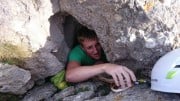







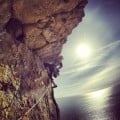



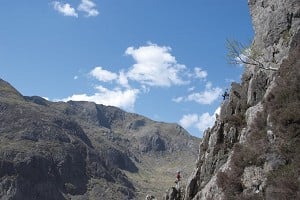
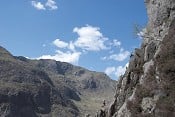
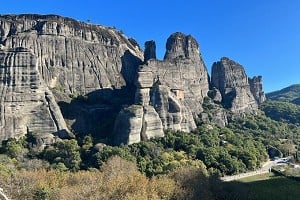
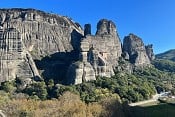



Comments
Great article Matt!
Went to uni in Swansea (UWTSD) though my trad head was usually clouded due to beer didn’t manage to tick half as much as I should have! Makes me want to come back, but without a hangover
Ah, home! So many memories.
My first ever rock climb, Classic (VD) at Boiler Slab - on a top rope 35 years ago.
My first ever lead, Scavenger (VS 4c) - it gave me the fright of my life, I barely wobbled up it and felt that all my gear was going to fall out. Several years later I returned on a baking hot day and soloed it to put the memory to rest.
My first HVS (something at Pennard) which I think has since been upgraded to E1. I vividly remember looking back at my last piece of gear (a bomber #9 nut), reaching blindly past the overhang and almost fainting with relief when my hand found a jug.
My first 'real' Extreme, Lazy Sunday Afternoon (E2 5b) - I was repeating Osiris (VS 4c), got to the roof and saw the massive thread and massive jugs, so I thought I'd go for it. I'm glad I did.
Several years later I over-confidently attempted to stroll up Seth (E1 5c), just to the right, and promptly and deservedly got spat off this most classic of sandbags (it would probably be E3 if it were 50 miles further west!).
Falling off Nick'd (E2 5b) at high tide, and having to prussic back up to the rock above a snarling sea.
Ticking both the E2s at Juniper Wall Third Sister to Zulu Zawn (a fantastic and under-rated crag), before going on to take the mother of all whippers off Talons (E2 6a) at Paviland. Fortunately the rather-dubious thread held.
Climbing Power Trap (E3 5c) to confirm that Gower actually does have some really quality Extremes (although I will admit that the best of the climbing is definitely sub-HVS).
Climbing Arch Slab (VS 4c) at high ride in the pissing rain, as part of a mountaineering-style mid-height traverse of Three Cliffs. That step across to the polished foot hold was a proper heart-in-mouth moment, and I was leading mid-extremes regularly by this point!
Completely failing on The Steal (E4 6a), and learning who 'Twizzle' was, and why the old guidebook description mentioned him!
And best of all, wild camping down at West Tor for my birthday, on a baking hot weekend with a big group of friends. We did buckets of sun-baked easy climbing, had beer-fueled long-jump competitions off the edge of dunes, and sat around a driftwood fire, telling stories late into the night.
Warrior :)